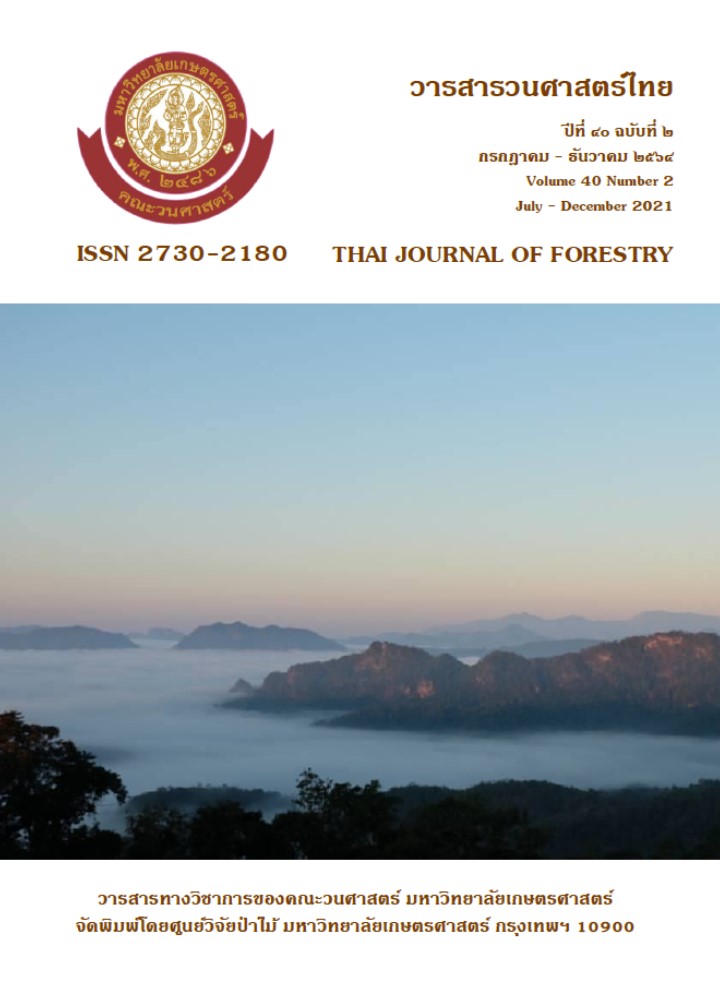คุณสมบัติถ่านไม้จากไม้พื้นที่สูงต่างถิ่น 5 สายพันธุ์ โดยกระบวนการเผาถ่านแบบสองขั้นตอนดัดแปลง
Main Article Content
บทคัดย่อ
งานวิจัยนี้ต้องการศึกษาคุณสมบัติถ่านไม้ที่ได้จากไม้ปลูกบนพื้นที่สูงเพื่อฟื้นฟูป่า ณ สถานีเกษตรหลวงอ่างขาง ที่มีศักยภาพจำนวน 5 ชนิด คือ การบูร นางพญาเสือโคร่ง เมเปิ้ลหอม จันทร์ทองเทศ และกระถินดอย โดยประยุกต์ใช้การเผาถ่านแบบสองขั้นตอนที่ถูกพัฒนาขึ้นในงานวิจัยนี้ร่วมกับเตาเผาถ่านดัดแปลงจากถังน้ำมันสองร้อยลิตร คือ เตา KP1 และ KP2 ที่ทางคณะผู้วิจัยได้ทำการศึกษาไว้ก่อนหน้านี้ ถ่านไม้ที่ได้ถูกนำมาวิเคราะห์คุณสมบัติด้านเชื้อเพลิงและคุณสมบัติด้านการดูดซับของถ่านไม้เปรียบเทียบกัน ได้แก่ การวิเคราะห์แบบประมาณ การวิเคราะห์แบบแยกธาตุ การวิเคราะห์ค่าความร้อน และการวิเคราะห์การดูดซับไอโอดีน ผลการศึกษาพบว่าเตาเผาถ่านทั้งสองชนิด ให้ค่าเฉลี่ยการวิเคราะห์ด้านเชื้อเพลิงและด้านการดูดซับมีความแตกต่างอย่างไม่มีนัยสำคัญ โดยพบว่าร้อยละความชื้นของกระถินดอยมีค่าเฉลี่ยต่ำสุดและการบูรมีค่าเฉลี่ยสูงสุด ที่ 4.70 และ 6.81 ตามลำดับ ร้อยละสารระเหยการบูรมีค่าเฉลี่ยต่ำสุดและกระถินดอยมีค่าเฉลี่ยสูงสุด ที่ 6.22 และ 12.35 ตามลำดับ ร้อยละขี้เถ้ากระถินดอยมีค่าเฉลี่ยต่ำสุดและการบูรสูงสุด ที่ 2.33 และ 5.86 ตามลำดับ ปริมาณคาร์บอนเสถียรของเมเปิ้ลหอมมีค่าเฉลี่ยต่ำสุดและการบูรมีค่าเฉลี่ยสูงสุด ที่ร้อยละ 77.00 และ 81.11 ตามลำดับ ซึ่งสอดคล้องกับผลการวิเคราะห์ร้อยละธาตุคาร์บอน ขณะที่ค่าความร้อน เมเปิ้ลหอม มีค่าเฉลี่ยต่ำสุดและกระถินดอยมีค่าเฉลี่ยสูงสุด ที่ 6,942.2 cal/g และ 7,458.9 cal/g ตามลำดับ โดยที่ค่าการดูดซับไอโอดีนมีค่าอยู่ระหว่าง 472.26 - 689.31 mgiodine/gcharcoal ซึ่งสูงกว่าค่าการดูดซับเฉลี่ยของถ่านไม้โดยทั่วไปและใกล้เคียงกับค่าขั้นต่ำของถ่านกัมมันต์ที่ 600 mgiodine/gcharcoal
Downloads
Article Details

อนุญาตภายใต้เงื่อนไข Creative Commons Attribution-NonCommercial-NoDerivatives 4.0 International License.
ข้าพเจ้าและผู้เขียนร่วม (ถ้ามี) ขอรับรองว่า ต้นฉบับที่เสนอมานี้ยังไม่เคยได้รับการตีพิมพ์และไม่ได้อยู่ในระหว่างกระบวนการพิจารณาตีพิมพ์ลงในวารสารหรือสิ่งตีพิมพ์อื่นใด ข้าพเจ้าและผู้เขียนร่วม (ถ้ามี) ยอมรับหลักเกณฑ์และเงื่อนไขการพิจารณาต้นฉบับ ทั้งยินยอมให้กองบรรณาธิการมีสิทธิ์พิจารณาและตรวจแก้ต้นฉบับได้ตามที่เห็นสมควร พร้อมนี้ขอมอบลิขสิทธิ์ผลงานที่ได้รับการตีพิมพ์ให้แก่วารสารวนศาสตร์ คณะวนศาสตร์ มหาวิทยาลัยเกษตรศาสตร์ กรณีมีการฟ้องร้องเรื่องการละเมิดลิขสิทธิ์เกี่ยวกับภาพ กราฟ ข้อความส่วนใดส่วนหนึ่ง หรือ ข้อคิดเห็นที่ปรากฏในผลงาน ให้เป็นความรับผิดชอบของข้าพเจ้าและผู้เขียนร่วม (ถ้ามี) แต่เพียงฝ่ายเดียว และหากข้าพเจ้าและผู้เขียนร่วม (ถ้ามี) ประสงค์ถอนบทความในระหว่างกระบวนการพิจารณาของทางวารสาร ข้าพเจ้าและผู้เขียนร่วม (ถ้ามี) ยินดีรับผิดชอบค่าใช้จ่ายทั้งหมดที่เกิดขึ้นในกระบวนการพิจารณาบทความนั้น”
เอกสารอ้างอิง
Junkaw, P. 2010. Technology transfer on construction and charcoal burning technique from 200 liters charcoal kiln. RMUTP sci.J. 4(1): 129-140. (in Thai)
Kuhakan, J. 2007. Charcoal and Wood Vinegar. Kasetthammachart. Bangkok. (in Thai)
Madhiyanon, T. 2015. Biomass Combustion. CDMK printing, Bangkok. (in Thai)
Pathpanth, K. 2003. Effect of Exotic Trees Thinning on Intercepted Water at the Royal Angkhang Agricultural Station, Changwat Chiang Mai. M.S. Thesis. Kasetsart University. (in Thai)
Phankham, K. 2004. Effect of Thinning on Growth, Water Use and Some Soil Properties of Exotic Trees Plantation on High Land. M.S. Thesis. Kasetsart University. (in Thai)
Phuymoontree, J. 2005. Making a charcoal and wood vinegar collection by kiln 200 liter. Appropriate Technology Association 6(6): 35-39. (in Thai)
Sajjakul, K. 2016. A Production of Bamboo Activated Charcoal Using Modified Charcoal Kilns: KP1 and KP2. M.S. Thesis. Kasetsart University. (in Thai)
Terasuwan, S. 2017. Soil Properties and Carbon Storage of Exotic Fast-growing-tree Plantations at the Royal Agricultural Station Angkhang, Chiang Mai Province. M.S. Thesis. Kasetsart University. (in Thai)
Tippayawong, N. 2010. Biomass Conversion. Technology Promotion Association (Thailand-Japan), Bangkok. (in Thai)


